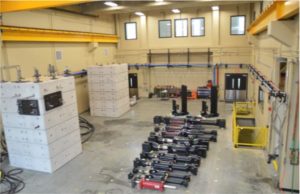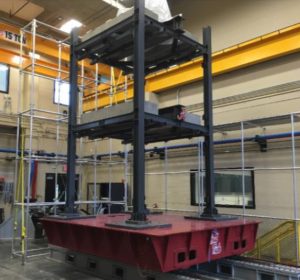The Large-Scale Structures Laboratory (LSSL), which is housed in the South Engineering Research Center on the UA campus, contains a 75 x 40-ft test floor with a 3-ft-thick strong floor, and two 15-ton capacity overhead cranes.
7 ft-4 in. x 7 ft-4 in. x 2-ft thick reconfigurable reinforced-concrete blocks that can be stacked and post-tensioned to the strong floor to provide reaction walls on the testing floor (see Figure 1).
13-ft x 12-ft uniaxial earthquake simulator that is capable of exciting a 40,000-lb payload to a peak acceleration of 1.2g, displacement of ±20 in., and maximum velocity of 45 in./sec within a frequency range of 0 to 30 Hz (see Figure 2)
A suite of eight MTS hydraulic actuators (see Figure 1) with large-flow servo valves, ranging in capacity from 35 to 330 kips, a high-capacity distribution system powered by an MTS Silent Flow Pump that can provide up to 720 GPM flow of high-pressure hydraulic fluid, service manifolds, and several digital controllers.
10 ft x 10 ft x 10 ft soil pit adjacent to the strong floor, with 5-ton capacity overhead crane, for geotechnical-related investigations including reduced-scale study of soil-structure interaction.
The LSSL is also well equipped with instrumentation including an Optotrak optical motion capture device capable of capturing simultaneously 3D displacements of 256 points up to a 0.004 in. accuracy, accelerometers, LVDT’s, load cells (500 lb to 400,000 lb), etc., and National Instruments high-speed data acquisition systems.


